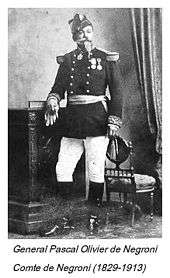Negroni
The Negroni is a popular Italian cocktail, made of one part gin, one part vermouth rosso (red, semi-sweet), and one part Campari, garnished with orange peel.[1] It is considered an apéritif.
| IBA official cocktail | |
|---|---|
 A Negroni | |
| Type | Cocktail |
| Primary alcohol by volume | |
| Served | On the rocks; poured over ice |
| Standard garnish | Orange slice |
| Standard drinkware |  |
| IBA specified ingredients | |
| Preparation | Stir into glass over ice, garnish and serve. |
| Timing | Before dinner |
A traditionally made Negroni is stirred, not shaken, and built over ice in an old-fashioned or rocks glass and garnished with a slice of orange. Outside of Italy an orange peel is often used in place of an orange slice.
History

While the drink's origins are unknown, the most widely reported account is that it was first mixed in Florence, Italy, in 1919, at Caffè Casoni (formerly Caffè Giacosa), on Via de' Tornabuoni and now called Caffè Roberto Cavalli. Count Camillo Negroni concocted it by asking the bartender, Fosco Scarselli, to strengthen his favorite cocktail, the Americano, by adding gin rather than the normal soda water. The bartender also added an orange garnish rather than the typical lemon garnish of the Americano to signify that it was a different drink.[2]
After the success of the cocktail, the Negroni family founded Negroni Distillerie in Treviso, Italy, and produced a ready-made version of the drink, sold as Antico Negroni 1919.[3] One of the earliest reports of the drink came from Orson Welles in correspondence with the Coshocton Tribune while working in Rome on Cagliostro in 1947, where he described a new drink called the Negroni, "The bitters are excellent for your liver, the gin is bad for you. They balance each other."[4]
Cocktail historian David Wondrich researched Camillo Negroni, whose status as a count is questionable, but whose grandfather, Luigi Negroni, was indeed a count.[5]
Descendants of General Pascal Olivier de Negroni, Count de Negroni, say he was the Count Negroni who invented the drink in 1857 in Senegal. A Corse-Matin Sunday Edition article from 1980 says he invented the drink around 1914.[6] An article in the New Hampshire Union Leader reported on the controversy.[7]
Variations
- Americano: 1 oz Campari, 1 oz sweet red vermouth, a splash of soda
- Boulevardier: uses whiskey in place of gin
- Old Pal: uses dry vermouth and Canadian rye whisky.
- Agavoni or Tegroni: uses tequila in place of gin.[8]
- Dutch Negroni: uses Jenever for the London dry gin[9]
- Fergroni: uses Punt e Mes instead of vermouth, in the style of chef Fergus Henderson[10]
- Negroni sbagliato: uses sparkling white wine or Prosecco in place of gin[11]
- White Negroni: gin, Lillet blanc, and Suze.[12]
See also
References
- Schaap, Rosie (May 21, 2014), "Negroni", The New York Times
- Cecchini, Toby (6 October 2002). "SHAKEN AND STIRRED; Dressing Italian". The New York Times. p. 913. Retrieved 2009-12-10.; Regan, Gary (29 March 2009). "Negroni history lesson ends in a glass". San Francisco Chronicle. p. e-6. Retrieved 2009-12-14.; Luca Picchi, Sulle tracce del conte. La vera storia del cocktail Negroni (On the Trail of the Count, The True Story of the Negroni Cocktail), Edizioni Plan, Florenz, 2002, ISBN 88-88719-16-4; Felten, Eric (2007). How's Your Drink?: Cocktails, Culture, and the Art of Drinking Well. Agate Surrey. p. 207. ISBN 1-57284-089-7.
- "Campari Academy e la Storia del Negroni". Mixer Planet. 2014-10-22. Archived from the original on 2016-06-22. Retrieved 2018-01-08.
- "Oxford English Dictionary negroni". Dec 2009. Retrieved 2009-12-29.
The bitters are excellent for your liver, the gin is bad for you. They balance each other.
; Coshocton Tribune, 17 December 1947 - Regan, Gary (2015). The Negroni: Drinking to La Dolce Vita, with Recipes & Lore. Potter/TenSpeed/Harmony. ISBN 1607747804. Retrieved 28 June 2017.
- "The newspaper article, "Corse Matin, 1980", Pascal". Archived from the original on 2015-12-08. Retrieved 2014-06-22.
- "Mark Hayward's City Matters". UnionLeader.com.
- Englesh, Camper (1 January 2012). "Negroni Cocktail. Der Playboy Unter Den Klassikern" [Negroni Cocktail. The Playboy Among The Classics]. Mixology.eu (in German). Archived from the original on 9 January 2018. Retrieved 16 December 2016.
- "Dutch Negroni".
- "Fergroni".
- "Campari Negroni sbagliato cocktail recipe". Campari. Archived from the original on 2016-09-15. Retrieved 2014-09-19.
- Allan, M. Carrie (7 July 2017). "The White Negroni Has Become a New Classic". The Washington Post. Washington, D.C.
External links
| The Wikibook Bartending has a page on the topic of: Negroni |
| Wikimedia Commons has media related to Negroni. |